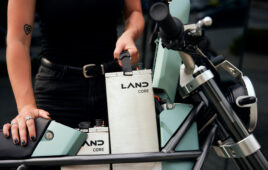Coatings in the windpower industry fall into at least three categories: Those applied to fasteners, those for blades, and others. Owner demands for increased reliability are driving trends in each. The results have been a wider variety and more specialized of coatings for other components.
Coatings on bolts
These are getting more attention, especially as wind plant developers look offshore. Different coating chemistries are used to improve corrosion protection, or lubricity, or both. However, increasing demands on field life, global legislation, and worldwide communization continue to create challenges for many traditional coatings.
A thorough understanding of a fastener’s coating performance can ensure joint integrity, as well as improve field life and serviceability. Global acceptance and availability are also key considerations in choosing the right coating.
A barrier coating is one way to protect ferrous substrates. It works as a barrier between a corrosive media and substrate. Such coatings, often organic and polymeric in nature, come in a wide array of colors and can be applied many ways, including electrophoresis (electrocoat). These can be extremely effective, but performance diminishes if the barrier (coating) is damaged during assembly. These defects, macroscopic and microscopic, are inevitable and give the environment access to the substrate. Once this happens, oxidation of iron, along with the cathodic reduction of dissolved oxygen, attributes to the generation of OH¯ (alkalinity). Generated alkalinity can react with the coating causing it to dis-bond or delaminate from the metal interface, ultimately causing coating failures.
Barrier protection works best when coating defects are kept to a minimum. Excessive coating damage diminishes the corrosion protection proportionally and leads to premature failures. Therefore, material handling is critical when this technology is used.
Sacrificial coatings, another protection option, include electroplating-galvanizing, hot dip galvanizing (HDG), along with inorganic-organic duplex coatings. Although the application method for sacrificial coatings can vary significantly, the protection mechanism is similar.
Sacrificial corrosion occurs when two dissimilar metals come in contact. The more active of the two metals in the cell becomes a sacrificial anode and cathodically protects the other. To protect steel fasteners from corrosion, they are often coated with metals of higher reactivity. Zinc-rich coatings, whether electroplated, galvanized, or non-electrolytically applied, offer cathodic protection for steel fasteners by letting the coating “sacrifice” itself in place of the ferrous fastener. This technology relies on the coating to preferentially corrode.
Sacrificial coatings are affected less by coating defects than barrier coatings. The coating, which contains a more reactive metal, still provides cathodic protection around small voids and defects. However, excessive material handling can diminish the performance of this technology as well.
Understanding how these two systems provide corrosion protection makes it clear why duplex systems can offer better protection than conventional galvanizing. The topcoat’s resistance of a corrosive media’s coming in contact with a sacrificial coating, delays the corrosion mechanism. What’s more, topcoats can be formulated to provide specific frictional characteristics.
Coatings for blades
These are also following several trends: Development of durable tapes and protection that rolls on like a paint. These are important to a blade’s leading edge because as the aerodynamic surfaces degrade, turbine performance falls off.
An advanced “thin-film” polyurethane primer along with a polyurethane topcoat are available for wind-turbine blades. The coating developer says a thinner can reduce labor, material use, and weight while the coating provides good adhesion, erosion resistance, and flexible protection properties.
The developer says the polyurethane primer and topcoat were designed together and that they use up to 60% less applied film than conventional polyurethane multicoats. The primer is said to deliver good adhesion to the composite substrate, an attribute required in wind-turbine-blade finishing. The primer dries quickly and can be topcoated in as little as 30 minutes.
The weather-resilient polyurethane topcoat is said to be extremely erosion-resistant and offer the smoothness and protection from environmental attack, features required in wind blade applications. The system is also VOC-compliant to 420 g/l. The two components balance performance properties that deliver long-term, low maintenance asset protection in any operating environment including challenging desert and offshore situations.
Coatings for electrical devices
Other less-frequently encountered coatings are specialized for particular components. For instance, the coatings above have been formulated for blades, towers, and bolts. An ultra-thin version works well on electronics and permanent magnets that will be used in direct drive generators.
Manufacturers of these metal coatings suitable for the wind industry say they are durable, cost-effective, and eliminate common delamination and pitting problems. The coatings spray or roll-on for coverage that’s resistant to harsh weather. Manufacturers say the resins and metals can be applied to almost any substrate. The resulting surface is said to look and wear like cast metal without the traditional expense or weight. The metal coatings do not conduct electricity, are non-corrosive, and can be finished, sanded, polished, brushed, machined, or given a patina just as any forged or cast metal.
For electrical components, a custom ultra-thin conformal coating provides magnets and ferrite cores with excellent dielectric properties, according to the developer. These could be useful in offshore wind turbines. With a lower dielectric constant, lower dissipation factor, and high dielectric strength compared to industry-standard coatings, these are well suited for electrical insulation on miniature wire wound components. Ultra-thin coatings also provide protection against abrasion damage that may occur during winding. Finally, the coating’s dry lubricity (a low coefficient of friction) is also beneficial when winding.
A few benefits to the ultra-thin material include the near elimination of faulty components while improving electrical performance. Using adhesive tape as insulation between winding and metal component is a well-established process. But as components get smaller, applying tape becomes difficult. Another plus: The coating provides increased strength to the often fragile molded plastic NdFeB magnetic components. NdFeB material is also susceptible to corrosion from atmospheric moisture. The extremely low water-vapor transmission properties provide excellent protection against corrosion. Lastly, ultra-thin coatings often also offer lower processing and labor costs because it is possible to coat many thousands of parts simultaneously using a tumble system during vapor deposition. WPE
Windpower Engineering & Development
Filed Under: Green engineering • renewable energy • sustainability




